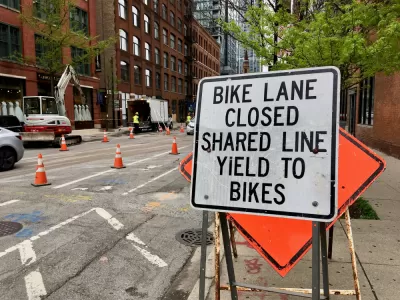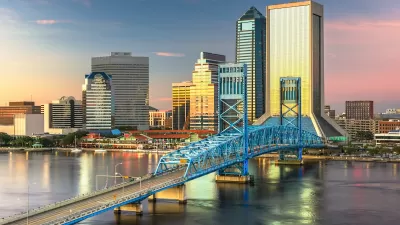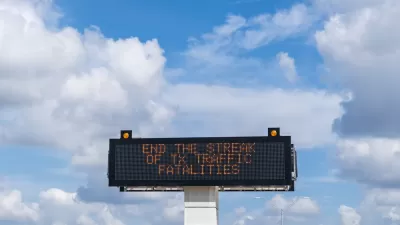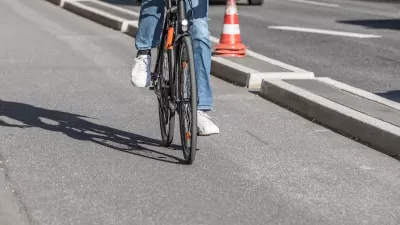Road infrastructure that fails to make dangerous driving behavior feel risky to drivers is ineffective in protecting pedestrians and people on bikes.

An article by Colin Anderson in Streetsblog Chicago illustrates the problem with the city’s pedestrian infrastructure, claiming that car-oriented design fails to prioritize pedestrian safety and contributes to rising rates of pedestrian and cyclist deaths.
According to Anderson, “There’s nothing about the street layout or infrastructure that leverages risk homeostasis to force motorists to slow down, let alone stop for pedestrians.” Anderson explains, “Painted bike lanes do not pose any risk to a driver or their car, which is why they are simply ignored, while concrete-protected bike lanes give drivers real consequences for getting too close.” The blame lies with state agencies, too: “Another crucial but less obvious roadblock to safer street design is the Illinois Department of Transportation, which often blocks meaningful pedestrian and bike safety improvements to the Chicago roads they control if there’s any risk that the changes might increase trip times for drivers.”
We need infrastructure that has safety, not danger, built into it.
To Anderson, the key to effective infrastructure is making dangerous behavior feel risky to drivers. “Fortunately, there are many, many traffic calming features which provide physical cues that force drivers to slow down, and these can be implemented in ongoing cyclical maintenance.” The lack of implementation of these types of low-tech projects is simply a lack of political will and poor coordination between government officials and agencies, Anderson writes, putting some of Chicago’s most vulnerable communities at disproportionate risk for traffic violence.
FULL STORY: Visualizing how current Chicago infrastructure fails people walking and biking

Study: Maui’s Plan to Convert Vacation Rentals to Long-Term Housing Could Cause Nearly $1 Billion Economic Loss
The plan would reduce visitor accommodation by 25,% resulting in 1,900 jobs lost.

North Texas Transit Leaders Tout Benefits of TOD for Growing Region
At a summit focused on transit-oriented development, policymakers discussed how North Texas’ expanded light rail system can serve as a tool for economic growth.

Why Should We Subsidize Public Transportation?
Many public transit agencies face financial stress due to rising costs, declining fare revenue, and declining subsidies. Transit advocates must provide a strong business case for increasing public transit funding.

How to Make US Trains Faster
Changes to boarding platforms and a switch to electric trains could improve U.S. passenger rail service without the added cost of high-speed rail.

Columbia’s Revitalized ‘Loop’ Is a Hub for Local Entrepreneurs
A focus on small businesses is helping a commercial corridor in Columbia, Missouri thrive.

Invasive Insect Threatens Minnesota’s Ash Forests
The Emerald Ash Borer is a rapidly spreading invasive pest threatening Minnesota’s ash trees, and homeowners are encouraged to plant diverse replacement species, avoid moving ash firewood, and monitor for signs of infestation.
Urban Design for Planners 1: Software Tools
This six-course series explores essential urban design concepts using open source software and equips planners with the tools they need to participate fully in the urban design process.
Planning for Universal Design
Learn the tools for implementing Universal Design in planning regulations.
Ascent Environmental
Borough of Carlisle
Institute for Housing and Urban Development Studies (IHS)
City of Grandview
Harvard GSD Executive Education
Toledo-Lucas County Plan Commissions
Salt Lake City
NYU Wagner Graduate School of Public Service





























